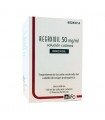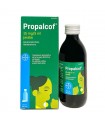Pseudoephedrine acts as a nasal decongestant.
It is indicated for local and temporary relief from nasal congestion associated with rhinitis, common cold and flu
adults and adolescents 12 and older.
You should see a doctor if it gets worse, if symptoms persist for more than 5 days.
UNITS LIMITED TO 10 UNITS PER ORDER.
ACTION AND MECHANISM
- [NASO/FARINGEO DECONGESTANT], [ALPHA-1 ADRENERGIC AGONIST]. Pseudoephedrine, a stereoisomer of ephedrine, behaves as an alpha-1 receptor agonist, and to a lesser extent beta receptors. Agonism over alpha-1 receptors results in vasoconstriction of blood vessels, including those of the nasal mucosa, decreasing blood content and mucosal swelling, resulting in a decongestant effect of the nasal passages. Moreover, the agonist effect on beta receptors could result in bronchodilation, decreasing airflow resistance.
On the other hand, pseudoephedrine, like ephedrine, behaves as an indirect agonist, being captured by the simpatic fiber, displacing the norepinephrine from its vesicles and favoring its release. Released norepinephrine may enhance the sympathomimetic effects of pseudoephedrine by acting on its receptors. However, this mechanism results in a depletion of catecholamine levels in the simpatic fiber, which would cause tachyphylaxis.
Pseudoephedrine has effects similar to those of ephedrine, although its vasoconstrictive activity and central effects are lower than those of ephedrine.
SPECIAL WARNINGS
- Regular monitoring of blood pressure in hypertensive patients and blood glucose is recommended in diabetic patients.
- It is advised to distance the IMAO and pseudoephedrine intake at least 14 days.
- It should not be administered in conjunction with other products containing nasal decongestants.
- The dose established should not be exceeded, with the duration of treatment being as short as possible.
Elderly
Patients aged 60 years or older are more susceptible to adverse reactions following the use of sympathomimetics, with cases of hallucinations, seizures, nervous depression and even death described. These effects may occur even at normal therapeutic doses.
In addition, the elderly may develop pathologies that could be worsened by the administration of sympathomimetics, as well as being in treatment with drugs with which this active substance could interact. It is recommended to closely monitor patients over 60 years of age, and discontinue treatment at the slightest indication of significant adverse reactions. A dosing readjustment may be necessary.
PATIENT ADVICE
- It is recommended not to exceed the recommended daily dose.
- Treatment should be discontinued and doctor should be used if symptoms persist for more than five days, if they worsen or if high fever, dizziness, insomnia or nervousness, tachycardia or heart palpitations, nausea, vomiting or persistent abdominal pain occur.
- The doctor or pharmacist should be notified if the patient has diabetes, heart disease, hypertension or glaucoma, as well as if he or she is being treated with any other drug.
- Discontinuation of treatment at least 24 hours before surgery is recommended.
Contraindications
- Hypersensitivity to any component of the medicine.
- Severe heart disease or uncontrolled diabetes.
- Patients in treatments with IMAO antidepressants within 14 days before initiating pseudoephedrine therapy (see Interactions).
- Children under 12 years old.
- [CLOSED ANGLE GLAUCOMA].
- [HYPERTHYROIDISM].
- [URINARY RETENTION].
- History of [CEREBRAL HEMORRAGIA] or risk factors for cerebral hemorrhage.
- Pregnancy and lactation.
Doping
Pseudoephedrine is a banned substance during competition.
It is prohibited when administration results in a concentration in urine greater than 150 mcg/ml.
Detection in a sample during competition of any amount of pseudoephedrine in combination with a diuretic or masking agent shall be considered an adverse analytical result, unless the athlete has obtained an approved therapeutic use authorisation (AUT) for ephedrine, in addition to that granted for the diuretic or masking agent.
It is considered a "specific substance" and, therefore, a violation of the rule in which this substance is involved may result in a reduction in sanction provided that the athlete can demonstrate that the use of the specific substance in question was not intended to increase his athletic performance.
Pregnancy
FDA Category C. In animal studies, pseudoephedrine has not resulted in significant teratogenic effects, although there have been cases of decreased average weight, length and ossification rate of the skeleton in the fetus. However, the causal link with pseudoephedrine could not be established. However, other sympathomimetic amines have resulted in teratogenic effects in some animal species.
Adequate and well-controlled human studies have not been conducted. Because animal reproduction studies are not always predictive of human response, and due to the vasoconstrictive properties of pseudoephedrine, the use of this drug is contraindicated in pregnancy, and is only accepted in case of absence of safer therapeutic alternatives, when the benefits outweigh the potential risks.
Pharmacokinetics
Orally:
- Absorption: Pseudoephedrine is absorbed quickly and almost completely after oral administration. No first-step effect has been observed. After administration of an oral dose of 120 mg pseudoephedrine, Cmax of 397-422 ng/ml is obtained after 1.84-1.97 hours, while administering this same dose in a prolonged release form delays absorption to a Tmax of 3.8-6.1 hours.
Effects may be prolonged up to 12 hours after administration of 120 mg orally in forms of prolonged release.
Food: Food seems to delay the absorption of pseudoephedrine, but when administered in forms of prolonged release, food hardly affects absorption.
- Distribution: Its ability to bind to plasma proteins is unknown. It has a vd between 2.64 and 3.51 l/kg. Pseudoephedrine is able to cross the placenta, and appears to be excreted in milk, obtaining 0.5% of the oral dose in milk after 24 hours.
- Metabolism: Pseudoephedrine is metabolized by N-demethylation in the liver, in an incomplete manner and less than 1%, resulting in an inactive metabolite.
- Elimination: Both pseudoephedrine and its liver metabolite are eliminated by urine, with 55-96% of pseudoephedrine unchanged. The elimination of pseudoephedrine is pH dependent, and accelerates in acidic urine. The elimination half-life is 3-6 hours (pH x 5) or 9-16 hours (pH x 8). The Cl is 7.3-7.6 ml/minute/kg.
Pharmacokinetics in special situations:
- Children: After administering a dose of 30-60 mg pseudoephedrine in children 6-12 years of age, Cmax values were obtained between 244 and 492 ng/ml after 2.1 and 2.4 hours and you of 2.6 and 2.4 l/kg respectively. It has an adult-like elimination half-life. Cl is somewhat higher than in adults, with values of 10.3-9.2 ml/minute/kg.
Indications
- Temporary and symptomatic relief of [CONGESTION NASAL] associated with [RINITIS], [COMMON COLD] or [GRIPE].
Interactions
- Urinary acidifying agents (ammonium chloride). Administration of ammonium chloride or any other acidifying drug could promote the elimination of pseudoephedrine, because this drug is a basic amine. A decrease in pharmacological activity may occur.
- Urinary alkalizers (sodium bicarbonate). Cases of patients have been reported where pseudoephedrine elimination half-life increased by 71-100% after administration of a urinary alkalizer. This effect could be due to the lower solubility of pseudoephedrine in basic urine, as it is a weak base.
- Anesthetics by inhalation. Administration of pseudoephedrine before or shortly after anesthesia with these anesthetics may increase the risk of severe ventricular arrhythmias, especially in patients with pre-existing heart disease, as anesthetics greatly sensitize the myocardium to the effects of sympathomimetics. In the event that the patient undergoes scheduled surgery, it is recommended to discontinue administration of this medicine at least 24 hours before the operation.
- Tricyclic antidepressants. Tricyclic antidepressants may enhance the vasopressive effects of sympathomimetic amines, leading to hypertensive seizures. It is recommended to avoid association.
- Antihypertensives. Joint administration of pseudoephedrine together with antihypertensives such as beta-blockers, methyldopa or diuretics may reduce antihypertensive activity, due to the vasopressive effects of pseudoephedrine. In addition, beta-blockers have resulted in cases of hypertensive crisis when administered with pseudoephedrine, due to beta blockage, which favors the increased binding of pseudoephedrine to alpha-adrenergic receptors. Regular monitoring of heart function and blood pressure is recommended.
- Digoxin. Simultaneous administration of digoxin with pseudoephedrine may increase the risk of cardiac arrhythmias.
- Nervous stimulants (amphetamines, cocaine, xanthines). Joint administration could enhance nerve stimulation, leading to intense excitability. It is recommended to avoid association. Cocaine could also increase cardiovascular side effects.
- Guanetidine. Pseudoephedrine opposes the sympatholytic effects of guanetidine, both by stimulating the release of norepinephrine and by binding to alpha-1 receptors. There is a risk of losing the therapeutic effects of guanetidine, with hypertension appearing. It is recommended to avoid association.
- Thyroid hormones. An enhanced effects of both drugs may occur, with a risk of high blood pressure and coronary insufficiency.
- IMAO (including linezolid). IMAO has resulted in enhancing the effects of pseudoephedrine due to inhibition of norepinephrine metabolism, intensified and prolonged the effects of vasopressants and cardiac stimulants, and leading to headache, cardiac arrhythmias, vomiting or hypertensive and/or sudden and intense hyperpyretic seizures. Pseudoephedrine should not be administered during treatment with IMAO or for 14 days after treatment with these drugs.
- Levodopa. Administration of levodopa together with sympathomimetics increases the risk of cardiac arrhythmias, so a decrease in the dose of the adrenergic agonist may be necessary.
- Nitrates. Pseudoephedrine acts as a vasoconstrictor, so it could antagonize the antianginose effects of nitrates. It is recommended to avoid association.
- Reserpina. Administration of reserpine may result in a reduction in the effects of indirect sympathomimetics such as pseudoephedrine, probably due to reserpine depletion of noradrenergic vesicles. It is recommended to avoid association.
- Sympathomimetics. An enhancer of the cardiovascular and neurological effects of both drugs may occur. It is recommended to avoid association.
Breast feeding
Pseudoephedrine is excreted with human milk in small amounts, and about 0.5% of the total dose administered orally is detected after 24 hours. Although this amount may be somewhat higher after repeated dosing, many specialists do not believe that these small amounts will force discontinuation of breastfeeding.
The use of pseudoephedrine has described a decrease in milk production in lactating women. Therefore, this medicine is contraindicated in lactating women.
Children
The safety and efficacy of the 120 mg dose of pseudoephedrine in children under 12 years of age have not been evaluated and is therefore not recommended for use.
Children older than that age may be especially sensitive to their side effects, so caution is recommended.
RULES FOR PROPER ADMINISTRATION
Capsules/tablets should be swallowed whole, without chewing or crushing, with the help of a glass of water or any other liquid. If it is too large to swallow, it is recommended to mix the contents with jam or jelly, and swallow it without chewing.
If pseudoephedrine is given at night, it is recommended to do so several hours before bedtime to minimize the possibility of insomnia, especially in patients with difficulty sleeping.
Concomitant taking of this medicine with food or beverages does not affect the efficacy of this medicine. Do not administer in conjunction with bitter orange juice.
Dosage
- Adults, oral: 120 mg/12 hours. Maximum daily dose: 240 mg. Minimum interval between doses: 12 hours.
- Children, oral:
* Children 12 years and older: 120 mg/12 hours.
* Children under 12 years of age: Safety and efficacy have not been evaluated.
POSOLOGY IN HEPATIC IMPAIRMENT
* Moderate or severe: Increased plasma concentrations. Consider reducing the dose.
POSOLOGY IN RENAL INSUFFICIENCY
Pseudoephedrine is mainly eliminated by urinary tract, so patients with renal impairment may require dose adjustment.
Precautions
- Patients where sympathetic stimulation could worsen their pathologies, such as those with [DIABETES], [GLAUCOMA], [CORONARY INSUFFICIENCY], [ISQUEMIC CARDIOPATIA], [CARDIAC ARRITMIA], [ARTERIAL HYPERTENSION], [HIPERTIROIDISM], [FEOCROMOCITOMA], [ANAEMIA] or [PROSTATIC HYPERPLASIA]. The use of pseudoephedrine or any other sympathomimetic may aggravate the symptoms of these diseases, so their use without an optional prescription is not recommended. In case of severe conditions, such as decompensated diabetes or severe heart disease, it may be advisable to avoid administration of pseudoephedrine (see Contraindications).
- Patients with [INTESTINAL OBSTRUCTION] should not use long-release oral forms without consulting the doctor.
- Caution should be exercised in patients receiving digitalis or being treated with ergotamínico-type vasoconstrictors.
- The benefit/risk ratio should be carefully evaluated in the following situations: severe [HEPATICA INSUFFICIENCY] or moderate to severe [RENAL INSUFFICIENCY], [PROSTATIC HYPERPLASIA], positive anamnesis of [BRONQUIAL SPASM], [PEPTICA ULCERA] estenosant, duodenal pylorological obstruction, history of [EPILEPSIA].
- As with other CNS stimulants, pseudoephedrine carries a risk of abuse. Administration at increasing doses may result in long-term toxicity. Continued use can lead to tolerance, which could lead to an increased risk of overdose. Depression may occur after rapid suppression of pseudoephedrine treatment.
- At therapeutic doses, no clinically significant interaction with alcohol has been demonstrated (for a blood alcohol level of 0.5 g/l). However, caution is recommended if alcohol is taken concomitantly.
EXCIPIENT PRECAUTIONS
This medicine can cause stomach discomfort and diarrhea because it contains hydrogenated castor oil.
ADVERSE REACTIONS
Side effects of this medicine are generally rare at recommended doses, although they may increase in intensity and severity at higher doses. The most common alterations are:
- Digestives. [NAUSEAS], [VOMITOS], [DISPEPSIA] and [MOUTH DRYNESS] may appear.
- Neurological/psychological. Cases of nerve stimulation are common, especially in sensitive patients. He usually studies with [NERVIOSISMO], [EXCITABILITY], [INSOMNIO], [MAREO] or [VERTIGO]. Cases of [ASTENIA], [CEFALEA] and [TEMBLOR] have most rarely been reported. In more severe cases, and usually associated with overdose, [ANXIETY], [SOMNOLENCIA], [CONVULSIONES] and [ALUCINATIONS] may occur.
- Cardiovascular. Pseudoephedrine may result in [CARDIACA ARRITMIA], with [TAQUICARDIA] and [PALPITATIONS], especially at high doses or in patients predisposed to sympathomimetic effects. [ARTERIAL HYPERTENSITENSION] and [BRADICARDIA] reflect may also occur.
- Respiratory. [DYSPNOEA].
- Genitourinarias. [URINARY RETENTION] may sometimes occur in patients with prostate hypertrophy.
- Ophthalmological. Cases of [BLEFAROESPASMO] have been reported, with [FOTOFOBIA] and [LAGRIMEO].
- Allergic/dermatological. Cases of [HYPERSENSITIVITY REACTIONS] have been reported, with [URTICARIA] and [EXANTEMATIC ERUPTIONS]. In the most severe cases [LEUCOPENIA], [AGRANULOCITOSIS] and [TROMBOCITOPENIA] have appeared.
- Generals. [HYPERHIDROSIS], [PALLOR].
ADVERSE REACTIONS RELATING TO EXCIPIENTS
- Containing castor oil may cause stomach discomfort and [DIARREA].
Overdose
Symptoms: In case of overdose, adrenergic symptoms associated with cardiac and nerve stimulation usually appear. Other symptoms may include excitability, nervousness, restlessness, hallucinations, irregularly and continuously beat tachycardia, high blood pressure, tachypnea and dyspnoea. Bradycardia and rebound hypotension have sometimes been reported. In the most severe cases, hypokalaemia, psychosis, seizures, coma and hypertensive crisis may occur.
Treatment: Recommended treatment consists of emetic administration and subsequent gastric lavage within 4 hours of overdose. Adsorbent charcoal is only useful if administered during the first hour, unless administered in forms of controlled release. Forced diuresis along with a urinary acidifying will increase the elimination of pseudoephedrine as long as kidney function is adequate. However, diuresis is not recommended in cases of severe overdose.
If absorption has already occurred, the individual should be kept under surveillance. It is recommended to monitor heart status and measure serum electrolyte levels. If there are signs of cardiac toxicity, intravenous use of propranolol may be indicated. Hypokalaemia can be treated with slow infusion of a diluted potassium chloride solution, monitoring serum potassium concentration during administration and several hours later. Diazepam may be given intravenously for delirium or seizures.
Ria V. published the 28/04/2024 following an order made on 20/04/2024
So happy with youre service. It came fast and propperly in the Netherlands.
Alex R. published the 18/02/2024 following an order made on 12/02/2024
Un trato estupendo
Iker V. published the 03/08/2023 following an order made on 30/07/2023
perfecto







































